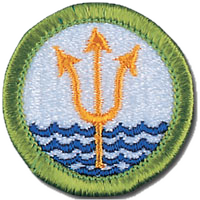Oceanography


Resources
- Oceanography Workbook
- Scoutmaster Bucky's Merit Badge Advancement Quick Reference
- Scoutmaster Bucky's Acknowledgement Form
Related
Oceanography Requirements Current Scouts BSA requirements
as of May 26, 2025
as of May 26, 2025
1.
Name four branches of oceanography. Describe at least five reasons why it
is important for people to learn about the oceans.
2.
Explain the following terms: salinity, temperature, density, and describe
how these important properties of seawater are measured by oceanographer.
Discuss the circulation and currents of the ocean. Describe the effects of
the oceans on weather and climate.
3.
Describe the characteristics of ocean waves. Point out the differences
among the storm surge, tsunami, tidal wave, and tidal bore. Explain the
difference between sea, swell, and surf. Explain how breakers are formed.
4.
Draw a cross-section of underwater topography. Show what is meant by:
a.
Continental shelf
b.
Continental slope
c.
Abyssal plain.
Name and put on your drawing the following: seamount, guyot, rift valley,
canyon, trench, and oceanic ridge. Compare the depths in the oceans with
the heights of mountains on land.
5.
List the main salts, gases, and nutrients in sea water. Describe some
important properties of water. Tell how the animals and plants of the ocean
affect the chemical composition of seawater. Explain how differences in
evaporation and precipitation affect the salt content of the oceans.
6.
Describe some of the biologically important properties of seawater. Define
benthos, nekton, and plankton. Name some of the plants and animals that
make up each of these groups. Describe the place and importance of
phytoplankton in the oceanic food chain.
7.
Do ONE of the following:
a.
Make a plankton net. Tow the net by a dock, wade with it, hold it in a
current, or tow it from a rowboat. Do this for about 20 minutes. Save
the sample. Examine it under a microscope or high-power glass.
Identify the three most common types of plankton in the sample.
b.
Make a series of models (clay or plaster and wood) of a volcanic
island. Show the growth of an atoll from a fringing reef through a
barrier reef. Describe the Darwinian theory of coral reef formation.
c.
Measure the water temperature at the surface, midwater, and bottom of a
body of water four times daily for five consecutive days. You may
measure depth with a rock tied to a line. Make a Secchi disk to measure
turbidity (how much suspended sedimentation is in the water). Measure
the air temperature. Note the cloud cover and roughness of the water.
Show your findings (air and water temperature, turbidity) on a graph.
Tell how the water temperature changes with air temperature.
d.
Make a model showing the inshore sediment movement by littoral
currents, tidal movement, and wave action. Include such formations as
high and low waterlines, low-tide terrace, berm, and coastal cliffs.
Show how offshore bars are built up and torn down.
e.
Make a wave generator. Show reflection and refraction of waves. Show
how groins, jetties, and breakwaters affect these patterns.
f.
Track and monitor satellite images available on the Internet for a
specific location for three weeks. Describe what you have learned to
your counselor.
8.
Do ONE of the following:
a.
Write a 500-word report on a book about oceanography approved by your
counselor.
b.
Visit one of the following and write a 500-word report about your
visit.
1.
Oceanographic research ship
2.
Oceanographic institute, marine laboratory, or marine aquarium.
c.
Explain to your troop in a five-minute prepared speech "Why
Oceanography Is Important" or describe "Career Opportunities in
Oceanography." (Before making your speech, show your speech outline to
your counselor for approval.)
9.
Describe four methods that marine scientists use to investigate the ocean,
underlying geology, and organisms living in the water.

